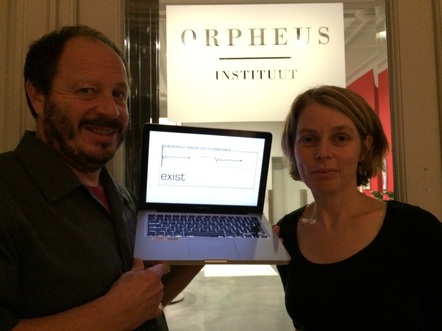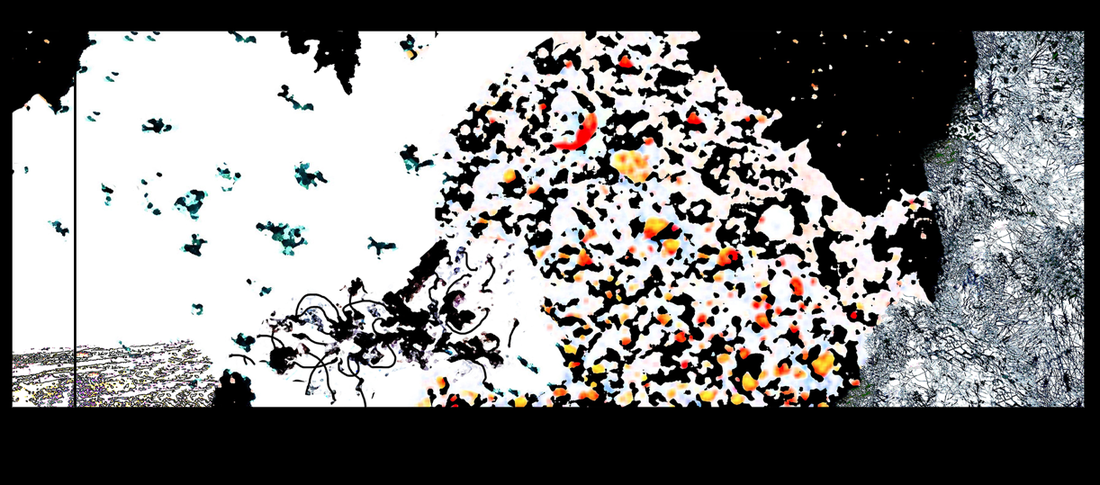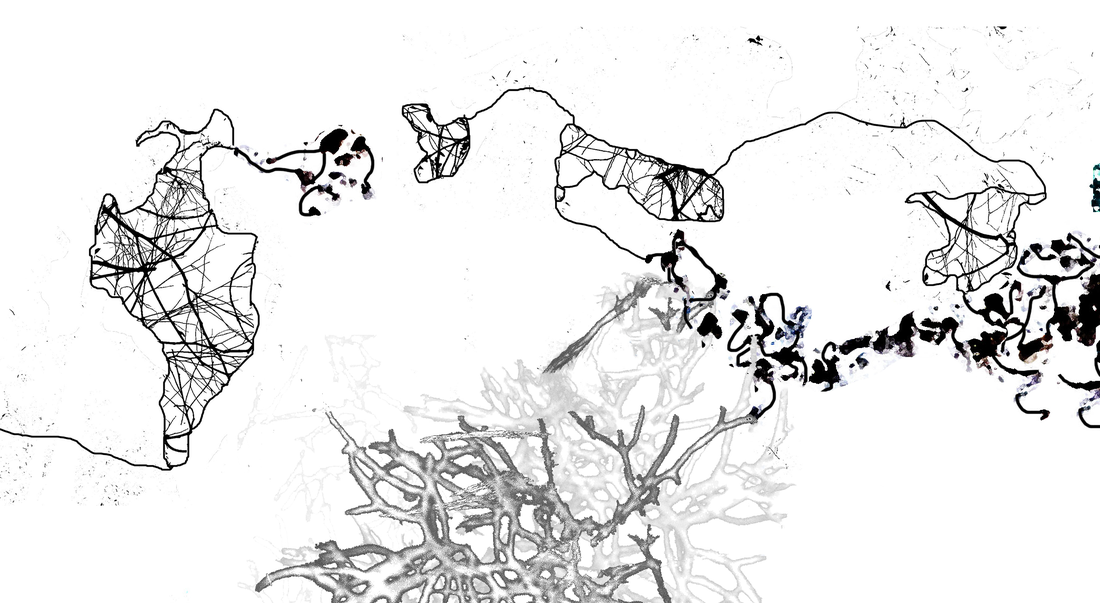2014
144 incidental music for Lorca's Blood Wedding [2014] for soprano saxophone, two guitars, celeste, double bass and percussion.24 instrumental works and songs with lyrics from Federico Garcia Lorca’s original text.
Performance 20141010 Roundhouse WAAPA ECU, Perth 10-16 October 2014. 45 minutes of music. |
143 in nomine tenebris [2014] for flute, clarinet, viola, cello, percussion and electronics
|
In Nomine Tenebris is something of a “through the looking glass” homage to Scelsi’s late period. The work takes Scelsi’s short organ work In Nomine Lucis (1974) as a “sound object” and subjects it to radical transformation and distortion. The compositional process involved visualising the work as a sonogram, stretching, warping and distorting the image and then resonifying it. The resonification was then visualised a second time and used as the basis of a score for the five acoustic instruments. The final work combines the acoustic instruments and the electronic sonification. The contours of the instrumental parts are used to control spatialisation and audio processing that expands and compresses the acoustic instrumental timbres in a manner analogous to the distortion of the visual image, but in real-time. Like many of Scelsi’s late works, In Nomine Tenebris focuses almost exclusively on timbre and the transitory nature of sonic spectra.
|
|
|
Performances:
20150806 Decibel – Inner Space: The Giacinto Scelsi Project, WAAPA Music Auditorium 20141110 Decibel – Inner Space: The Giacinto Scelsi Project, Melbourne Recital Centre |
142 murmurs trapped in the bark [2014] for clarinet and electronics
|
The sounds of “murmurs trapped in the bark” were generated from clarinet and manipulated to evoke microsounds of the hidden world beneath the tree bark. A scrolling spectrogram-type score of the recording was created using self-devised software. The image was then processed in Photoshop and Illustrator. It is an “artificial field recording” – a constructed soundscape suggesting an imaginary environment. The live clarinet is manipulated using similar processes to those employed in the recording.
Performances:
20160305 Nature Forms: lindsay vickery and ANU New Music Ensemble, collected resonances, ANU Canberra. 20140720 Lindsay Vickery, Vs Interpretation, Skolska 28, Prague |
141 the semantics of redaction [2014] for instrument(s) and generative score (variable media)
|
The Information Revolution brought brought with it what seemed at first to be a greater openness of information. It appears increasing redaction of information is the new direction for global media: be it “the right to be forgotten” by Google or the blank pages of the shooting incident report for Ferguson resident Michael Brown. In the semantics of redaction the performer loads a recording of a topical news item into a scoreplayer which both renders and redacts it asscrolling notation. Musical “stems” and “noteheads” are generated to correspond with accents detected in the recorded speech and the noteheads are colour-coded to represent timbres. The notation is also sometimes obscured by large black “redactangles” and accompanying sonic bleeps. The work was written for and is dedicated to Vanessa Tomlinson.
|
|
|
Performances:
20161202 Brian Smith Staller Center for the Arts Recital Hall, Stonybrook University, NY. 20160301 Greywing Lunchtime Concert, WAAPA Music Auditorium 20160305 Nature Forms: lindsay vickery and ANU New Music Ensemble, collected resonances, ANU Canberra. 20151009 silent revolution, The Firehouse Space Brooklyn 20151007 nature forms, Hartt School of Music, Hartford 20150930 International computer music conference, Denton, Texas 20150205 Spectral Manipulation, California Institute of the Arts, A300 20150130 Þögla Byltingin | Silent Revolution Dark Music Days Festival, Reykjavik 20140912 Vanessa Tomlinson, 8 Hits, Queensland Conservatorium, Brisbane20140720 Lindsay Vickery, Vs Interpretation, Skolska 28, Prague |
|
140 sacrifical zones [2014] for clarinet and electronics
Medley and Haddad discuss visual representation as a continuum ranging between photographic realism and textual description. They describe the realism continuum as “a visual model that presents any image as a series of pictures, iteratively reduced in fidelity from its referent”. (Medley and Haddad 2011:145).
Scored forms of musical representation occupy a similar continuum, in this case between the spectrogram (a precise frequency/time/amplitude representation of sound) and text scores that verbally describe the required sound.
|
In his “Days of Destruction, Days of Revolt” Chris Hedges details a number of places in the US which he describes as “sacrificial zones”, places that have essentially been abandoned by society and government. One of the places he visits is Camden New Jersey. It was once a hub of industry, but has become a no-go zone with large homeless camps, ruled by gangs, with a permanent underclass of unemployed. The graphical score (the rightmost image above) for Sacrificial Zones is a collage created from images of Camden.
Sacrificial Zones is a rhizomatic score in which the performer reads along intersecting pathways that are orientated both vertically and horizontally. In addition, the score is comprised of five layers each notated in a different manner: non-semantic, semantic, traditional, proportional and spectrogram (image below). The notated score was evolved from improvisations based on "readings' of the non-semantic notation. The amplified sound of the live clarinettist is diffused to four (or eight) speakers in a spatial location analogous to the position of the performer on the score. The electronically processed signal follows a separate path through the space. One instantiation of the pathways (clarinet blue - processing green) is shown to the left.
|
The material to be realized by the performer is specified by a moving circle on the score. The work unfolds indeterminately along its rhizomatic pathways, and also cross-fades between the five notational paradigms.
The clarinet performance is processed by delay, pitch shift, distortion, spectral manipulation and ring modulation. |
|
|
Performances:
20150205 Spectral Manipulation, California Institute of the Arts, A300 20150130 Þögla Byltingin | Silent Revolution Dark Music Days Festival, Reykjavik 20140720 Lindsay Vickery, Vs Interpretation, Skolska 28, Prague 20140710 Lindsay Vickery, Australasian Computer Music Conference 2014, VCA, Melbourne 20140429 Lindsay Vickery, Noizemaschin!! #34, The Artifactory, Perth |
139 nature forms I [2014] for three instruments and electronics
|
A score comprising manipulated images of organic shapes is simultaneously sonified by performers and software. Three performers read from the same scrolling score in three different ways: Player 1 reads semantically with the notation indicating pitch vertically, duration horizontally and shade timbrally, Player 2 reads the notation as tablature, spatially indicating which region of their instrument to be stuck with shade indicating the manner in which it is stuck, and Player 3 as non-semantic
graphical notation, realising the it primarily an aesthetic indication of the character of the sound to be created.
Screen-shot from the scrolling scoreplayer
|
The scores of each of the three players fade to black indeterminately throughout the performance creating changing combinations of 1, 2 and 3 players. The control panel above shows progress through the score (red line), the points at which there will be a change of instrumental combination (black lines) and the spatial position of each part. The score is simultaneously sonified using frequency, amplitude, brightness, noisiness and bark scale data to control the spatialisation and processing of the sonification data.
|
Version Two of the score for nature forms I (above) and a spectrogram of its sonifcation (below)
Sonification of the score for nature forms I (below)
|
|
Blog Posts:
9/05/2014 • Performances:
20160305 Nature Forms: lindsay vickery and ANU New Music Ensemble, collected resonances, ANU Canberra. 20151007 Nature Forms, Hartt School of Music, Hartford 20140327 Axis21, Spectral Crossings, WAAPA Music Auditorium, Perth 20140914 International Computer Music Conference, Onassis Cultural Centre, Athens, Greece |
138 Lyrebird - environment player [2014] for performer(s) and generative score (variable media)
|
Lyrebird is a scoreplayer that generates a visualisation of the sonic features of a recorded environment, as a form of score/improvisation guide. It is a “near real-time” work, in that percussionist Vanessa Tomlinson makes a new field recording and collects relevant objects to play for each performance. The work’s “site specific” nature was inspired both by Vanessa the improviser, and by tales of the epic outback trek she took with her family in the previous year. The score she reads is an alternate form of spectrogram that displays principal sonic features of the recording as shapes, and colours them according to their timbral properties. The visualisation scrolls right to left across the screen and the source recording is delayed, so that is heard as the corresponding images in the “score” reaches the left of the screen. This process is aimed at creating openness in the notation by foregrounding elements of timbre and texture rather than pitch or rhythm, providing a space that assists sonic imagination to guide an improvisation.
Version 2 of the Environment player: added a analysis and scaling patch, more finely grained analysis and uses jitter lcd.
|
The video shows visualisations of a magpie carolling, a section of Ligeti's Atmospheres and Schaeffer's Etude Chemins de Fer.
|
|
|
Performances:
20170423 Sounds Unbound Music of Visitors Spectrum Project Gallery. 20170405 Clocked Out - 8 Hits Plus, WAAPA 20160721 Hamish Upton: Lyrebird Environment Player. Australian Percussion Gathering 2016. Griffith University, Brisbane. 20140912 Vanessa Tomlinson, 8 Hits, Queensland Conservatorium, Brisbane 20150604 ANAM RECITAL - HAMISH UPTON |





























